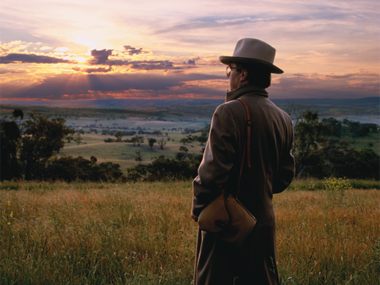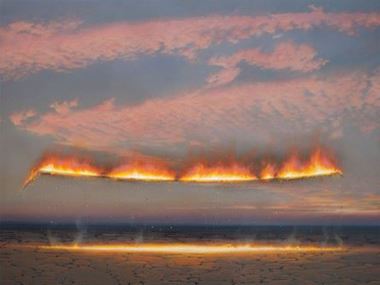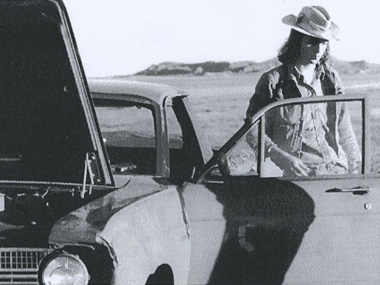Man on Fire: the Art of Tim Storrier and Other Desert Masters

Tim Storrier in what he refers to as 'Neolithic TV' - the Australian Outback. The photographer is Hari Ho. Used with permission.
Frannie Hopkirk | 20.05.14
Author: Frannie Hopkirk
Polarities between Australia’s artists and painters, black or white, achieve compatibility and oneness of intent when they collectively embrace the one big thing about this country – THE DESERT. Storrier, Nolan, Drysdale etc. ‘white’ painters; Paddy Bedford, Tommy Watson, Emily Kngwarreye etc., ‘black’ painters, are all united by this same unduckable reality.
It could be said that the desert is how Australians of all kinds define themselves. If The First Australians lived and thrived in, mapped and understood the desert, white ‘‘European’ Australians, fearful of the enigma and terror of space, ran from it or made art out of it. They did not base sacred belief systems on it. You need centuries to do that.
If you have ever flown over the Centre you will have experienced what ‘space’ really looks like. And where Sidney Nolan was coming from. Hour after hour after hour of desert in all its colour, texture, formation, mystery, leaves one feeling like a Space Cadet impatient to land. And it IS scary.
Comparisons based on whether or not art-works are in narrative form. Whether artists are exploring in the personal sense, their own imaginations or emotions and ideas. The important unifying element, black or white, whatever the stories or human dramas, no matter the terror, beauty and fear, (from Papunya or The National Art School,) all express the same thing: relationships to Land and Country. Earth, fire, wind, water.
All forms of Aboriginal Dreaming relate to aspects of nature, from Kangaroos, Lizards, Dingoes to Fire and Water. Storrier’s original yet eternally ancient choice of subject matter is a personal interpretation of Fire Dreaming. He is the white master who has taken or borrowed Fire as his power symbol.
Born the son of a grazier in Central West NSW Storrier has country in his DNA. From birth he has known the turgid, agonizing torment, as well as the visual poetry, of extended drought. He is hard-wired for DRY. As Peter Kingston has made Sydney Harbour his own, Tim Storrier has taken the desert deep into his psyche. His famous fire pictures are an account of one man’s emotional as well as graphic engagement with the Red Centre.
Unlike Aboriginal desert masters who as a rule only begin painting as senior elders, when their age in traditional law has deemed them sufficiently qualified and experienced. Storrier, now 65 would be considered morally ready for the responsibility of representing his culture in paint.
He, however, has a very different story. Winning the Sulman Prize for Genre when he was barely out of school, thereby having celebrity thrust upon him before he had time to find out what kind of a painter he really was or what he would become has himself become a senior artist, an elder. He stands now as one of the all time greats of Australian art. Before he could claim this, 35 years of hard work, travel, reading, taking photographs, a passionate private life, an interest in politics and love of music, winner of prizes and awards, a international reputation, have confirmed and enhanced the celebrity which began at 18.
His nomadic spirit has taken him on repeated trips to the desert, both here and in Egypt and the US. It is his soul place. Here he expands. Something happens - what Nicolas Rothwell calls the “quicksilver youthful skies”, and importantly, also from Rothwell – the ability to “think magically”. Both Storrier and Rothwell are familiar with the absorbing silence ‘out there’.
Packing a couple of bottles of good red, steaks and his Directors chair, he absorbs to cellular level the great lonely fantasy of the Outback. What he calls Neolithic TV. One can see him there – smoke rising from his campfire, the tents, the chair, the glass of red, the companions, his romance with the horizon, his essential aloneness, and the ‘magical thinking’ which alchemizes his vision into vast vibrating canvases.
The single Big Idea stemming from Storrier’s desert ponderings have been his Fire pictures. Carefully setting up and arranging his materials: stretching a thick rope between two wide-apart points, drenching the rope in boat oil, then with camera loaded, waiting for dusk. In the moment before dark when the horizon glows, he sets the rope alight.
Like many ideas of genius this gesture has marked Storrier. The paintings and lithographs stemming from what is titled “Point to Point” are profound, graphically stunning, dramatic, enigmatic as the desert itself. Again, playing with fire, he has arranged huge camp- fires where he conflagates what appears to be symbols from his life and imagination. These are visceral, intensely detailed, vaguely nihilistic canvases with a peculiar emotion one can never quite get a handle on. “Thinking magically?”
Complex pictures like this can be called narrative but not in the sense that Aboriginal Art is narrative. Tim is not telling stories of history, food gathering, sex, ceremonies, Corroborees, who can paint and who cannot.
From where the hunting is good, the food is plentiful, the water pure, to initiation rites, the white onlooker cannot decipher the coded surfaces because they not literal. This is the art of elitism and abstraction. The secrets hidden beneath flowing lines, dots, ravishing paint and a God-like design- sense, holds truths even scholars will never know. The pleasing graphics do not give up their secrets, nor should they.
Is there a danger of the old masters of the desert dying out and taking their secrets with them? Have the last forty years of the dramatic emergence of Indigenous art been a phenomena and a warning, where the true mysteries have found their way into the mainstream of galleries and collections, never to be reproduced, or buried so deep they may never fully understood?
Who will paint the masterpieces of the future? Who will replace the Kngwarreyes, Tommy Bedford, Tommy Watson, Rover Thomas, Bill Whiskey, Kitty Kantilla, Queenie Kemarre, Ada Bird, Angelina Pwerle, Lena Nyadbi, Minnie Pwerle, Patsy Marfura, Eubena Nampitjin and all the others? Is this a threatened world? Notions like this do indeed make the spear quiver.
With a command of paint and brush grounded in traditional techniques: Storrier layers glaze over glaze, some opaque, achieving what has been called ‘the Leonardo effect’, a rich deepening of colour. Through skill he expresses the secrets of his hidden self. Both cerebral and emotional, strange and beautiful. As masterpieces from the desert artists define what great art is, Storrier masterpieces stand among them. Black art and white art seems not so polarized after all.
Tim Storrier’s paintings are as dry as his wit, which can be savagely funny. BW (Brett Whiteley) once said that Tim’s pictures gave him “scurvy” for lack of green; what Shakespeare referred to as the “livery of wanton green”. He was my brother’s great friend. If you were lucky you could hang-in on some of their arguments. He is my great friend also. I always see him in his studio, standing in front of one of his enormous canvases, one leg cocked, one hand on his hip, the other holding a brush, music playing and sometimes a fire in the grate.
Watch an interview with Tim Storrier (with Stuart Purves from Australian Galleries) produced as part of the Fairfax Media Australia Day Project. Purchase Blaze Line
View our Six Masters Exhibition
Share this:
»  del.icio.us
»
del.icio.us
»  Digg it
»
Digg it
»  reddit
»
reddit
»  Google
»
Google
»  StumbleUpon
»
StumbleUpon
»  Technorati
»
Technorati
»  Facebook
Facebook
Contact Details

The art of Tim Storrier honours fire as a constant in the Australian landscape, here with Blaze Line (2014), commission by the Age and featured in the Fairfax Media Australia Day Project 2014.

A young Tim Storrier photographed here in the Outback. Brett Whiteley once said that Tim’s pictures gave him “scurvy” for lack of green.
Further Research
News Tags: Ada Bird | Angelina Pwerle | Bill Whiskey | Desert Masters | Drysdale | Emily Kngwarreye | Eubena Nampitjin | Frannie Hopkirk | Kitty Kantilla | Lena Nyadbi | Minnie Pwerle | Nicolas Rothwell | Nolan | Patsy Marfura | Peter Kingston | Queenie Kemarre | Rover Thomas | Sidney Nolan | Tim Storrier | Tommy Bedford | Tommy Watson
News Categories: Feature
News Archive
- 11.10.17 | RETURN OF MUNGO MAN
- 10.10.17 | TARNANTHI 2017
- 11.08.17 | Natsiaas 2017
- 08.08.17 | ABORIGINAL ART ECONOMICS
- 02.08.17 | SCHOLL'S NEXT MOVE
- 20.07.17 | APY ART DOMINATES THE WYNNE
- 17.07.17 | Anangu Artist Wins $100,000 Prize
- 14.07.17 | The End of AAMU
- 13.07.17 | YOU ARE HERE
- 11.07.17 | ART ACROSS THE COUNTRY
- 11.07.17 | TARNANTHI IN OCTOBER
- 05.07.17 | TJUNGUṈUTJA - from having come together
- 02.07.17 | BENNELONG
- 27.06.17 | JIMMY CHI
- 23.06.17 | Blak Markets at Barangaroo
Advertising

